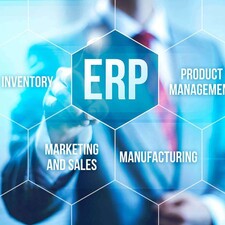Blog
There are Two I's in Team: The Power of the IIoT

Summary
The IIoT is transforming the Fabrication & Assembly Industry
First came the IoT, or internet of things, connecting virtually anything and everything that could be connected. Now its "big brother," the IIoT - industrial internet of things - is transforming the way the various parts and pieces of the supply chain converge - and converse - on the assembly line.
Other than the length of their requisite acronyms, the primary difference between the two is that the industrial version is used to drive far-reaching financial and infrastructure decisions. Its "little brother," on the other hand, can be used for applications as commercialized as end consumer convenience and/or reassurance. Both scale, and both have sufficiently blurred application lines to blend borders at some points, an innovative leap that offers a better operational presence for consumer and manufacturer alike.
Learn More About IIoT - Download This Guide: How to Leverage IIoT with Modern ERP
What Does the IIoT Do?
If you've ever used Bluetooth for earphones or a smartphone application, you've used a miniaturized concept of the IoT - a connectivity solution that allows you to seamlessly see and control one object or concept with another. For example, when you wave your RFID-enabled credit card at a reader as you check out at a store, the reader knows to debit your card for the purchase amount, and a connected smartphone app knows to send a push message that the card has been used. The store gets the appropriate amount of money, you stay informed on your purchases, and your card issuer knows to debit your account for that amount as well - all in seconds without any effort on your part. The IoT & IIoT perform similar acts of transparency as products move down an assembly line, through a supply chain, and potentially even off of store shelves in both the physical world and its counterpart eCommerce space.
The industrial internet of things performs these connections and communications on a larger scale, adjusting for potential surpluses and shortfalls of raw materials all the way through the supply chain. This ensures that any "ripple effects" - and their associated costs - don't have a chance to make a gouge in overall operational efficiency. According to a recent study, this approach is expected to increase revenues for IIoT-linked companies by 10% or more over the next five years. Is a production machine down overseas? The IIoT might signal that associated production machines won't be needed stateside until it's repaired, enabling manufacturers to reallocate their assembly line and warehouse workers. This enables a business to more closely align with peak efficiency and keep their estimates and targets grounded in reality, ultimately improving the process all the way to the end consumer.
IIoT from Supply Chain to Warehouse
No matter what products or services are being sold, the real commodity in modern business is data, and, once properly aligned, the IIoT serves up a virtually unlimited amount. The global supply chain in particular benefits from rigorous use of interconnected machines, transportation, and manufacturing nodes, as existing obstacles - language barriers, time zones, tariffs, and other timeless struggles - already provide more than enough challenges. When an overseas company knows how close a domestic warehouse or assembly unit is to capacity, they can adjust their output accordingly. This translates to less wasted cubes in shipping containers, lower tariff bills, and potentially more affordable overall costs for industries that use perishable or time-sensitive components.
Knowing true production capacity is crucial for manufacturing and assembly facilities
Once goods arrive domestically, or are created here to begin with, the IIoT continues to assist. Knowing true production capacity is crucial for manufacturing and assembly facilities - the data provided by production machines will dictate how many employees need to be added or taken away from a team to balance cost and benefit, and give clear indications when another line or facility is necessary. Even data as mundane as collective work-hours on individual production machines are helpful, as these can be tied to mandatory maintenance schedule to prevent costly breakdowns and repairs.
IIoT: Beyond Plug-and-Play
As convenient as a suite of plug-and-play IIoT products would be for supply chains and manufacturing alike, the truth is that the growing complexity of the concept makes it virtually impossible. With consultants and systems diverging from one another, setup takes a similar tack to choosing a warehouse, or deciding on a 3PL carrier. It's a big decision, and it's also one with a success rate that closely follows the amount of time and effort put into its installation. The IIoT should not run parallel to existing processes, it should define those processes by its nature - otherwise, it's simply another method of data-gathering, albeit without labor-intensive employee-centric reporting.
When a company decides to hop on the proverbial IIoT train, they should ask some reflective questions and use their answers to determine when, where, and how they need IIoT technology implemented:
- What do we need to know, in terms of data, in order to operate at peak efficiency?
- Are our supply chain partners willing to contribute to / join an IIoT setup?
- Do any of our partners currently use IIoT technology? Can we use the same tech?
- What is our initial cost to implement and connect an IIoT?
- Will that cost be greater than the perceived value of the data it provides?
- Are we likely to need an IIoT for regulatory or reporting purposes in the future?
The more "yes" answers from this list, the more likely an IIoT setup will be helpful, rather than a neutral addition to existing workflows. As with any tech addition, there may be some push back or questioning at the beginning, but ultimately the IIoT is about making jobs across the board easier by degrees of magnitude, and minimizing the potential negative effects of errors in judgment. Through that lens, even the most resistant team members or C-suite decision-makers should see the reasoning behind this innovative twist on management and forecasting.
While it's been getting considerable buzz in recent months, the IIoT isn't a fad - it's here to stay. In fact, the BBC reports that the IIoT concept stands to add as much as 14.2 trillion to global GDP in the next 12 years. Much like recent trends in 3PL management or eCommerce growth, it has the power to transform the business landscape for decades to come.
For more on topics like this, sign up for our Content Library, a collection of high-value whitepapers, guides, case studies, videos on ERP, digitization, IIoT, and more!


